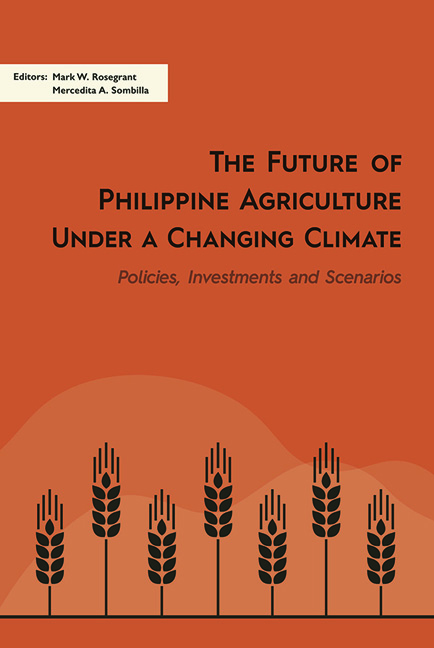Book contents
- Frontmatter
- Contents
- List of Tables
- List of Figures
- List of Appendices
- Preface
- Acknowledgements
- List of Contributors
- PART I Setting up the Scenarios: Current Status and Potential Impacts of Climate Change to Philippine Agriculture
- 1 Current Structure and Future Challenges of the Agricultural Sector
- 2 The Context of Land Cover Changes in Agriculture and Forestry
- 3 Trends in Agricultural Water Resources
- 4 Existing Evidence of Climate Change and Variability
- PART II Climate Change Adaptation Strategies and Sustainability of Philippine Agriculture
- PART III Investments and Supporting Policies to Alleviate Climate Change Impacts to Philippine Agriculture
- PART IV Conclusion
- Index
3 - Trends in Agricultural Water Resources
from PART I - Setting up the Scenarios: Current Status and Potential Impacts of Climate Change to Philippine Agriculture
Published online by Cambridge University Press: 29 May 2019
- Frontmatter
- Contents
- List of Tables
- List of Figures
- List of Appendices
- Preface
- Acknowledgements
- List of Contributors
- PART I Setting up the Scenarios: Current Status and Potential Impacts of Climate Change to Philippine Agriculture
- 1 Current Structure and Future Challenges of the Agricultural Sector
- 2 The Context of Land Cover Changes in Agriculture and Forestry
- 3 Trends in Agricultural Water Resources
- 4 Existing Evidence of Climate Change and Variability
- PART II Climate Change Adaptation Strategies and Sustainability of Philippine Agriculture
- PART III Investments and Supporting Policies to Alleviate Climate Change Impacts to Philippine Agriculture
- PART IV Conclusion
- Index
Summary
One of the pathways through which climate change will be felt is its impact on water resources (WEPA 2012). This includes increased risk in the form of excess water, water shortages, poor water quality, and disruptions to freshwater ecosystems due to higher water temperatures, increased intensity and duration of precipitation, longer periods of low flows, and higher operating costs (Kundzewicz et al. 2007). Dependence on and overexploitation of groundwater can result from the unreliability of surface water supplies, while at the same time changes in precipitation patterns increase the incidence of flooding. Increased water risks and growing uncertainty about future conditions are already exacerbating existing water security challenges in the Philippines and have implications for water-related planning, management, and investment decisions. Adapting to new circumstances will require knowledge-based investment strategies and adaptive water governance, taking into account climate variability and minimizing potentially costly mismatches between water systems and the future climate.
This chapter outlines trends in water resource investments and agricultural water uses, focusing on irrigation projects, for the purpose of examining the preparedness of the agricultural sector to respond to the adverse impacts of climate change. While the literature on these impacts is mixed, lack of action could be more costly than a proactive, anticipatory approach. The increased recognition of the need to consider and mainstream the implications of climate change in government initiatives should be matched by increased preparation rather than a cursory or “business as usual” response. The next section outlines potential climate change adaptation strategies relating to water and irrigation. Thereafter, the climate change strategy of the National Irrigation Administration (NIA) is presented, followed by a discussion of trends in public investments in irrigation at national and subnational levels, which reflect planning, management, and decision making about agricultural water allocation and use. The chapter concludes with policy implications. (Details of the data and methodology utilized are provided in Box 3.1.)
CLIMATE CHANGE ADAPTATION IN THE IRRIGATION SECTOR
Irrigation and water are key sectors in need of climate change adaptation. In water-stressed areas, approaches should include applying irrigation, improving irrigation efficiency, adopting water-efficient technologies to harvest water and conserve soil moisture, developing and adopting improved varieties and species with resistance to heat and drought, and reviewing or developing other policies beyond the water sector.
- Type
- Chapter
- Information
- The Future of Philippine Agriculture under a Changing ClimatePolicies, Investments and Scenarios, pp. 133 - 173Publisher: ISEAS–Yusof Ishak InstitutePrint publication year: 2018

